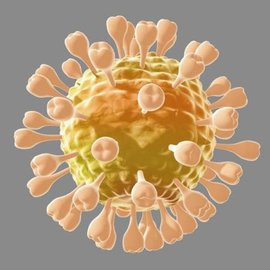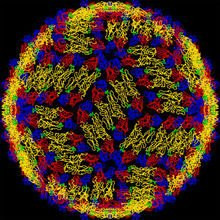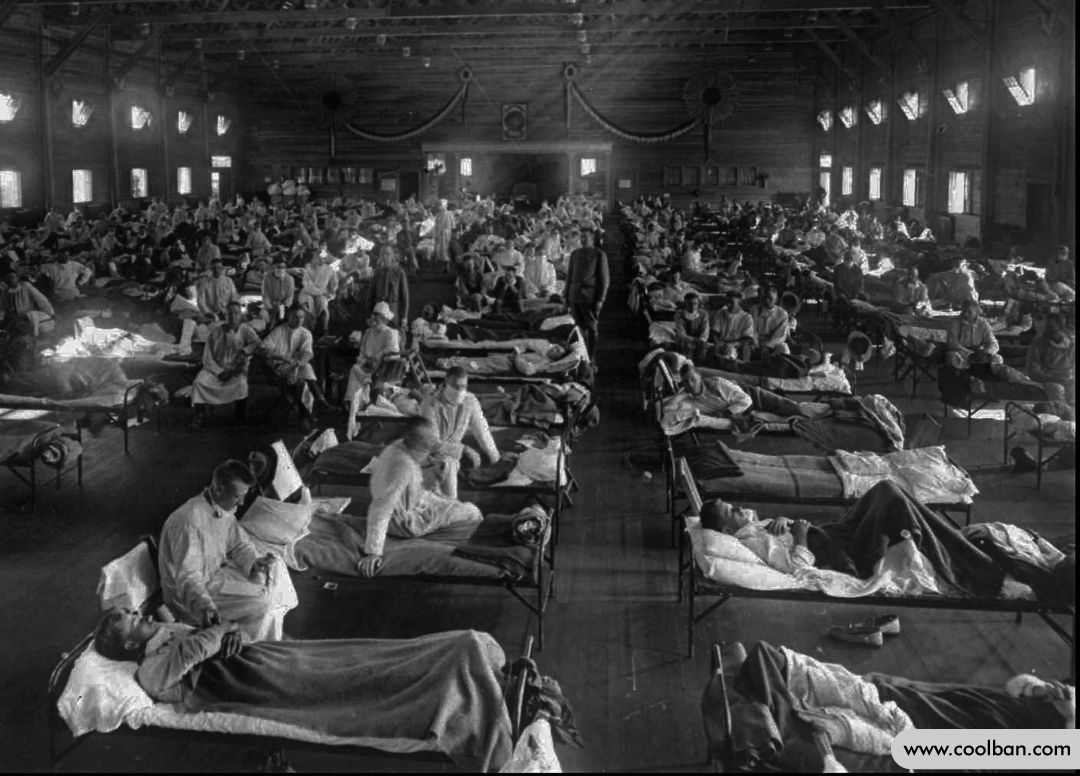10 Most Dangerous Viruses in the World
2022-06-09
NO.1 The most dangerous virus in history: Ebola virus
Appeared in central Africa in 1976, it is unknown where it came from. The Ebola virus can shatter the human body, causing blood to ooze from every pore in an infected person. The risk is high, with 90 percent of those infected dying.

NO.2 The most dangerous virus in history : Smallpox virus
Smallpox (Smalpox) is a dangerous and severe infectious disease caused by the smallpox virus, and it is also the first infectious disease that has been eradicated by humans in the world so far. The average incubation period for people infected with variola virus is about 12 days (7-17 days).
Initial symptoms after infection include: high fever, fatigue, headache and back pain. After 2-3 days, the typical dangerous smallpox rash is visibly distributed over the face, arms, and legs. In the early stages of a person's rash, there may also be reddish patches that accompany the rash. The lesions began to purulent after a few days until the scabs began to form in the second week. Over the next 3-4 weeks it slowly develops into mange and then slowly peels off. Smallpox is caused by infection with the pox virus, which is so dangerous that there is no cure. People will have pockmarks on their faces after they recover, hence the name "smallpox".

NO.3 The most dangerous in history Virus: AIDS
AIDS is a dangerous infectious disease caused by infection with HIV (HIV). HIV is a virus that attacks the body's immune system. It takes the most important T lymphocytes in the human immune system as the main target of attack, and destroys the cells in large quantities, making the human body lose its immune function, which is very dangerous. Therefore, the human body is easily infected with various diseases, and human malignant tumors can occur, and the mortality rate is relatively high. The incubation period of HIV in the human body is 8 to 9 years on average. Before a person suffers from AIDS, he can live and work for many years without any symptoms and danger.

NO.4 The most dangerous virus in history : Polio
Polio, also known as polio, has killed more than 10,000 people since 1916 and is very dangerous. Polio is a dangerous viral infection that is spread through a person's mouth or anus.
Although 9 in 10 people do not show symptoms caused by the virus, some people do show symptoms once the virus enters the circulation. When the virus enters the human nervous system, it destroys our motor neurons, causing dangerous flaccid paralysis.

NO.5 The most dangerous virus in history: Lassa fever virus
Lassa fever is caused by an arenavirus that doctors first noticed in the 1950s. Once infected with the virus, a person's internal organs can bleed dangerously, blood pressure plummets, the brain is damaged, and the situation is dangerous. One in seven infected people dies.

NO.6 The most dangerous virus in history: Dengue virus
It is an endemic disease in tropical regions. It is spread through mosquito bites, causing massive visceral hemorrhage in humans. Up to 50% of those infected die
Dengue virus is a small flavivirus belonging to the genus Yellow fever virus, which can cause acute infectious disease of dengue fever, usually transmitted by Aedes aegypti and Aedes albopictus that bite people during the day. Dengue fever virus can cause a series of clinical symptoms, including life-threatening Hemorrhagic shock syndrome and less commonly acute hepatitis with liver failure and encephalopathy. Infection with dengue virus can range from sudden fever, severe muscle pain, and bone and joint pain to extensive bleeding and rapid shock in severe cases.

NO.7 The most dangerous virus in history: Ma Qiubo virus
An arenavirus, first discovered in Bolivia in 1962, carried by mice. The initial symptoms of the infection are fever, then the nose and gums begin to bleed, gastrointestinal bleeding, and 30% of those infected die.
This is an arenavirus. First discovered in Bolivia in 1962, the virus is carried by mice. The initial symptoms of the infection are fever, then the nose and gums begin to bleed, gastrointestinal bleeding, and 30% of infected people die. Viruses are small but powerful.
The nucleus of a healthy cell carries the genetic material -- the genes -- that the virus targets. Viruses inject their own DNA into the genes of cells, causing them to make more copies of the virus. The way viruses invade cells is very complicated, but viruses are parasitic organisms, and once these newly made viruses leave the body, they must find a new body as soon as possible, or they will become extinct.

NO.8 The most dangerous virus in history: Spanish flu
In 1918, when World War I ended, 37 million people were killed in the war worldwide, and millions of soldiers began to return home. That's when a new disease emerged, which some call the Spanish flu, or the flu of the century and the 1918 flu. The disaster took 20 million lives in a matter of months. Within a year, the flu continued to spread and the death toll was staggering. An estimated 50 million to 100 million people have died from the disease worldwide. The flu is considered to be the most dangerous plague in human history. The Spanish flu was different from the common flu we now experience every year. It was a new type of influenza virus called the H1N1 bird flu virus.
Scientists suspect the virus was transmitted to humans from birds in the U.S. Midwest before World War I. It later killed 8 million people in Spain, and the flu became known as the "Spanish flu". Globally, most humans are completely invulnerable to this virus, just as The plight of the Aztecs in the face of smallpox in 1550. Large-scale transports and supply forces facilitated the rapid spread of the virus to other regions.

NO.9 The most dangerous in history Virus: Black Death
Cars were piled with corpses, wooden boards were littered with dead family members, and nobles and peasants wailed in unison, hoping to enter heaven for deliverance. This is the Black Death, the most terrifying infectious disease in human history. The Black Death is considered to be the first truly large-scale epidemic. In Europe in 1348, half of the people died from the Black Death.
At that time, many people in China and India also died as a result. The Black Death continued to spread along the routes of war and trade. The cities and villages along the way were completely destroyed, and the global politics and economy were dealt a fatal blow. The Black Death has long been considered an epidemic and dangerous plague, spread by fleas on rats and through the air.
But recent research questions this. Some scientists think the Black Death may have been a haemorrhagic virus similar to Ebola. Scientists are studying the remains of suspected plague victims, hoping to find some genetic evidence to support the theory.

NO.10 The most dangerous virus in history Virus: Malaria
Malaria is not a new infectious disease. The earliest records of malaria appear 4,000 years ago, when the Greeks described its devastating effects. The earliest references to mosquito-borne diseases appear in ancient Indian and Chinese medical books. Even now, people have found that many diseases are related to mosquitoes. Malaria is generally caused by protozoan microorganisms in mosquitoes and humans. Plasmodium microbes enter the body when infected mosquitoes settle on human skin and start sucking blood. Once in the blood, it grows within and eventually destroys red blood cells. Dangerous symptoms range from mild to severe, with a typical symptom being a fever. Chills, sweats, headache and muscle pain.
Malaria is a dangerous infectious disease caused by Plasmodium parasites in humans. Infection through the bite of Anopheles mosquitoes or the transfusion of the blood of a person with Plasmodium. Different malaria parasites cause Plasmodium vivax, Plasmodium vivax, Plasmodium falciparum, and Plasmodium ovale, respectively. The disease is mainly manifested as periodic and regular attacks, with chills, fever, and sweating all over the body. After repeated attacks for a long time, it can cause anemia and splenomegaly. Malaria is endemic in 102 countries and regions, and according to the World Health Organization (WHO) estimates, 2 billion people live in endemic risk areas, especially in some countries in Africa, Southeast Asia, and Central and South America, where the mortality rate of falciparum malaria is extremely high. In the 1930s, malaria spread almost across the country. After years of efforts, the incidence rate has been greatly reduced, and by 1992 the number of cases nationwide dropped to 70,000.
Due to the imperfect primary health organizations in many areas, the situation of under-reporting or non-reporting of the epidemic situation is still serious. Relevant experts estimate that the actual number of cases is 1 to 3 times more, but the overall downward trend is certain. It must also be clearly seen that there are still nearly 300 million people in 546 counties (cities) in about 15 provinces (autonomous regions) still under the threat of malaria, and the epidemic situation in some areas fluctuates greatly, small-scale outbreaks continue, and the southern region is vicious. The number of cases of dangerous malaria has increased, so malaria control remains an important part of infectious diseases.

Appeared in central Africa in 1976, it is unknown where it came from. The Ebola virus can shatter the human body, causing blood to ooze from every pore in an infected person. The risk is high, with 90 percent of those infected dying.

NO.2 The most dangerous virus in history : Smallpox virus
Smallpox (Smalpox) is a dangerous and severe infectious disease caused by the smallpox virus, and it is also the first infectious disease that has been eradicated by humans in the world so far. The average incubation period for people infected with variola virus is about 12 days (7-17 days).
Initial symptoms after infection include: high fever, fatigue, headache and back pain. After 2-3 days, the typical dangerous smallpox rash is visibly distributed over the face, arms, and legs. In the early stages of a person's rash, there may also be reddish patches that accompany the rash. The lesions began to purulent after a few days until the scabs began to form in the second week. Over the next 3-4 weeks it slowly develops into mange and then slowly peels off. Smallpox is caused by infection with the pox virus, which is so dangerous that there is no cure. People will have pockmarks on their faces after they recover, hence the name "smallpox".

NO.3 The most dangerous in history Virus: AIDS
AIDS is a dangerous infectious disease caused by infection with HIV (HIV). HIV is a virus that attacks the body's immune system. It takes the most important T lymphocytes in the human immune system as the main target of attack, and destroys the cells in large quantities, making the human body lose its immune function, which is very dangerous. Therefore, the human body is easily infected with various diseases, and human malignant tumors can occur, and the mortality rate is relatively high. The incubation period of HIV in the human body is 8 to 9 years on average. Before a person suffers from AIDS, he can live and work for many years without any symptoms and danger.

NO.4 The most dangerous virus in history : Polio
Polio, also known as polio, has killed more than 10,000 people since 1916 and is very dangerous. Polio is a dangerous viral infection that is spread through a person's mouth or anus.
Although 9 in 10 people do not show symptoms caused by the virus, some people do show symptoms once the virus enters the circulation. When the virus enters the human nervous system, it destroys our motor neurons, causing dangerous flaccid paralysis.

NO.5 The most dangerous virus in history: Lassa fever virus
Lassa fever is caused by an arenavirus that doctors first noticed in the 1950s. Once infected with the virus, a person's internal organs can bleed dangerously, blood pressure plummets, the brain is damaged, and the situation is dangerous. One in seven infected people dies.

NO.6 The most dangerous virus in history: Dengue virus
It is an endemic disease in tropical regions. It is spread through mosquito bites, causing massive visceral hemorrhage in humans. Up to 50% of those infected die
Dengue virus is a small flavivirus belonging to the genus Yellow fever virus, which can cause acute infectious disease of dengue fever, usually transmitted by Aedes aegypti and Aedes albopictus that bite people during the day. Dengue fever virus can cause a series of clinical symptoms, including life-threatening Hemorrhagic shock syndrome and less commonly acute hepatitis with liver failure and encephalopathy. Infection with dengue virus can range from sudden fever, severe muscle pain, and bone and joint pain to extensive bleeding and rapid shock in severe cases.

NO.7 The most dangerous virus in history: Ma Qiubo virus
An arenavirus, first discovered in Bolivia in 1962, carried by mice. The initial symptoms of the infection are fever, then the nose and gums begin to bleed, gastrointestinal bleeding, and 30% of those infected die.
This is an arenavirus. First discovered in Bolivia in 1962, the virus is carried by mice. The initial symptoms of the infection are fever, then the nose and gums begin to bleed, gastrointestinal bleeding, and 30% of infected people die. Viruses are small but powerful.
The nucleus of a healthy cell carries the genetic material -- the genes -- that the virus targets. Viruses inject their own DNA into the genes of cells, causing them to make more copies of the virus. The way viruses invade cells is very complicated, but viruses are parasitic organisms, and once these newly made viruses leave the body, they must find a new body as soon as possible, or they will become extinct.

NO.8 The most dangerous virus in history: Spanish flu
In 1918, when World War I ended, 37 million people were killed in the war worldwide, and millions of soldiers began to return home. That's when a new disease emerged, which some call the Spanish flu, or the flu of the century and the 1918 flu. The disaster took 20 million lives in a matter of months. Within a year, the flu continued to spread and the death toll was staggering. An estimated 50 million to 100 million people have died from the disease worldwide. The flu is considered to be the most dangerous plague in human history. The Spanish flu was different from the common flu we now experience every year. It was a new type of influenza virus called the H1N1 bird flu virus.
Scientists suspect the virus was transmitted to humans from birds in the U.S. Midwest before World War I. It later killed 8 million people in Spain, and the flu became known as the "Spanish flu". Globally, most humans are completely invulnerable to this virus, just as The plight of the Aztecs in the face of smallpox in 1550. Large-scale transports and supply forces facilitated the rapid spread of the virus to other regions.

NO.9 The most dangerous in history Virus: Black Death
Cars were piled with corpses, wooden boards were littered with dead family members, and nobles and peasants wailed in unison, hoping to enter heaven for deliverance. This is the Black Death, the most terrifying infectious disease in human history. The Black Death is considered to be the first truly large-scale epidemic. In Europe in 1348, half of the people died from the Black Death.
At that time, many people in China and India also died as a result. The Black Death continued to spread along the routes of war and trade. The cities and villages along the way were completely destroyed, and the global politics and economy were dealt a fatal blow. The Black Death has long been considered an epidemic and dangerous plague, spread by fleas on rats and through the air.
But recent research questions this. Some scientists think the Black Death may have been a haemorrhagic virus similar to Ebola. Scientists are studying the remains of suspected plague victims, hoping to find some genetic evidence to support the theory.

NO.10 The most dangerous virus in history Virus: Malaria
Malaria is not a new infectious disease. The earliest records of malaria appear 4,000 years ago, when the Greeks described its devastating effects. The earliest references to mosquito-borne diseases appear in ancient Indian and Chinese medical books. Even now, people have found that many diseases are related to mosquitoes. Malaria is generally caused by protozoan microorganisms in mosquitoes and humans. Plasmodium microbes enter the body when infected mosquitoes settle on human skin and start sucking blood. Once in the blood, it grows within and eventually destroys red blood cells. Dangerous symptoms range from mild to severe, with a typical symptom being a fever. Chills, sweats, headache and muscle pain.
Malaria is a dangerous infectious disease caused by Plasmodium parasites in humans. Infection through the bite of Anopheles mosquitoes or the transfusion of the blood of a person with Plasmodium. Different malaria parasites cause Plasmodium vivax, Plasmodium vivax, Plasmodium falciparum, and Plasmodium ovale, respectively. The disease is mainly manifested as periodic and regular attacks, with chills, fever, and sweating all over the body. After repeated attacks for a long time, it can cause anemia and splenomegaly. Malaria is endemic in 102 countries and regions, and according to the World Health Organization (WHO) estimates, 2 billion people live in endemic risk areas, especially in some countries in Africa, Southeast Asia, and Central and South America, where the mortality rate of falciparum malaria is extremely high. In the 1930s, malaria spread almost across the country. After years of efforts, the incidence rate has been greatly reduced, and by 1992 the number of cases nationwide dropped to 70,000.
Due to the imperfect primary health organizations in many areas, the situation of under-reporting or non-reporting of the epidemic situation is still serious. Relevant experts estimate that the actual number of cases is 1 to 3 times more, but the overall downward trend is certain. It must also be clearly seen that there are still nearly 300 million people in 546 counties (cities) in about 15 provinces (autonomous regions) still under the threat of malaria, and the epidemic situation in some areas fluctuates greatly, small-scale outbreaks continue, and the southern region is vicious. The number of cases of dangerous malaria has increased, so malaria control remains an important part of infectious diseases.

